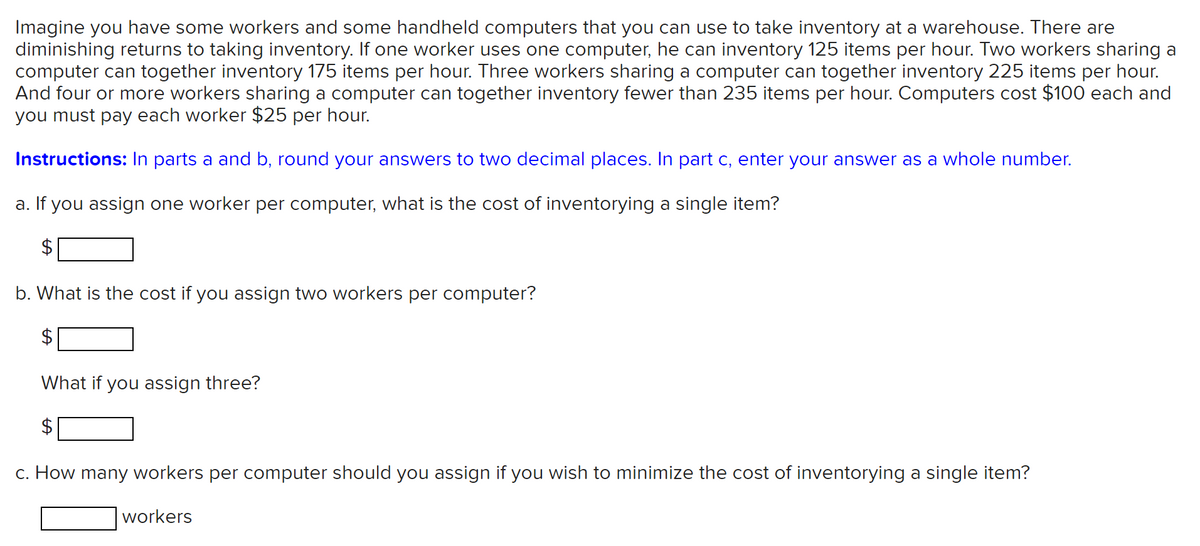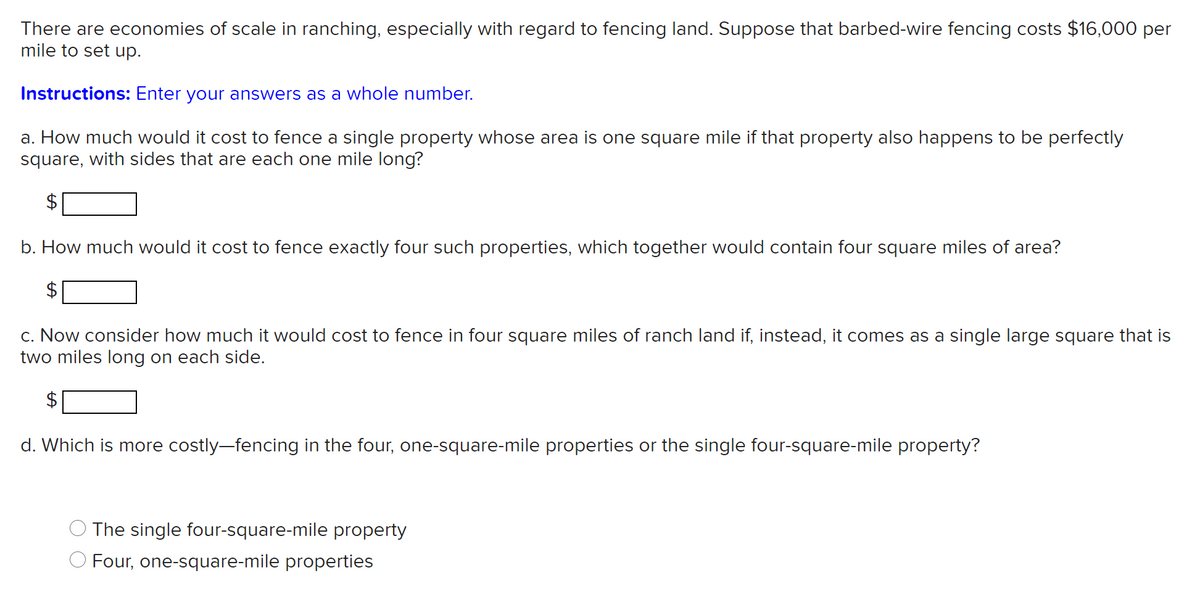Imagine you have some workers and some handheld computers that you can use to take inventory at a warehouse. There are diminishing returns to taking inventory. If one worker uses one computer, he can inventory 125 items per hour. Two workers sharing a computer can together inventory 175 items per hour. Three workers sharing a computer can together inventory 225 items per hour. And four or more workers sharing a computer can together inventory fewer than 235 items per hour. Computers cost $100 each and you must pay each worker $25 per hour. Instructions: In parts a and b, round your answers to two decimal places. In part c, enter your answer as a whole number. a. If you assign one worker per computer, what is the cost of inventorying a single item? 2$ b. What is the cost if you assign two workers per computer? 2$ What if you assign three? 2$ c. How many workers per computer should you assign if you wish to minimize the cost of inventorying a single item? workers
Imagine you have some workers and some handheld computers that you can use to take inventory at a warehouse. There are diminishing returns to taking inventory. If one worker uses one computer, he can inventory 125 items per hour. Two workers sharing a computer can together inventory 175 items per hour. Three workers sharing a computer can together inventory 225 items per hour. And four or more workers sharing a computer can together inventory fewer than 235 items per hour. Computers cost $100 each and you must pay each worker $25 per hour. Instructions: In parts a and b, round your answers to two decimal places. In part c, enter your answer as a whole number. a. If you assign one worker per computer, what is the cost of inventorying a single item? 2$ b. What is the cost if you assign two workers per computer? 2$ What if you assign three? 2$ c. How many workers per computer should you assign if you wish to minimize the cost of inventorying a single item? workers
Intermediate Financial Management (MindTap Course List)
13th Edition
ISBN:9781337395083
Author:Eugene F. Brigham, Phillip R. Daves
Publisher:Eugene F. Brigham, Phillip R. Daves
Chapter12: Capital Budgeting: Decision Criteria
Section: Chapter Questions
Problem 20P: The Aubey Coffee Company is evaluating the within-plant distribution system for its new roasting,...
Related questions
Question
100%
Info in images

Transcribed Image Text:Imagine you have some workers and some handheld computers that you can use to take inventory at a warehouse. There are
diminishing returns to taking inventory. If one worker uses one computer, he can inventory 125 items per hour. Two workers sharing a
computer can together inventory 175 items per hour. Three workers sharing a computer can together inventory 225 items per hour.
And four or more workers sharing a computer can together inventory fewer than 235 items per hour. Computers cost $100 each and
you must pay each worker $25 per hour.
Instructions: In parts a and b, round your answers to two decimal places. In part c, enter your answer as a whole number.
a. If you assign one worker per computer, what is the cost of inventorying a single item?
$
b. What is the cost if you assign two workers per computer?
2$
What if you assign three?
c. How many workers per computer should you assign if you wish to minimize the cost of inventorying a single item?
workers

Transcribed Image Text:There are economies of scale in ranching, especially with regard to fencing land. Suppose that barbed-wire fencing costs $16,000 per
mile to set up.
Instructions: Enter your answers as a whole number.
a. How much would it cost to fence a single property whose area is one square mile if that property also happens to be perfectly
square, with sides that are each one mile long?
2$
b. How much would it cost to fence exactly four such properties, which together would contain four square miles of area?
c. Now consider how much it would cost to fence in four square miles of ranch land if, instead, it comes as a single large square that is
two miles long on each side.
2$
d. Which is more costly-fencing in the four, one-square-mile properties or the single four-square-mile property?
The single four-square-mile property
O Four, one-square-mile properties
Expert Solution
This question has been solved!
Explore an expertly crafted, step-by-step solution for a thorough understanding of key concepts.
This is a popular solution!
Trending now
This is a popular solution!
Step by step
Solved in 5 steps

Knowledge Booster
Learn more about
Need a deep-dive on the concept behind this application? Look no further. Learn more about this topic, accounting and related others by exploring similar questions and additional content below.Recommended textbooks for you

Intermediate Financial Management (MindTap Course…
Finance
ISBN:
9781337395083
Author:
Eugene F. Brigham, Phillip R. Daves
Publisher:
Cengage Learning

Cornerstones of Cost Management (Cornerstones Ser…
Accounting
ISBN:
9781305970663
Author:
Don R. Hansen, Maryanne M. Mowen
Publisher:
Cengage Learning

Intermediate Financial Management (MindTap Course…
Finance
ISBN:
9781337395083
Author:
Eugene F. Brigham, Phillip R. Daves
Publisher:
Cengage Learning

Cornerstones of Cost Management (Cornerstones Ser…
Accounting
ISBN:
9781305970663
Author:
Don R. Hansen, Maryanne M. Mowen
Publisher:
Cengage Learning